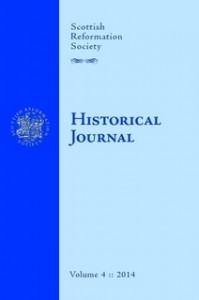 Scottish Reformation Society Historical Journal, vol. 6
Scottish Reformation Society Historical Journal, vol. 6
Douglas Somerset (ed.),
Scottish Reformation Society, pbk, 285 pp., £9.95
This new volume of historical papers from the Scottish Reformation Society maintains the high standard set by previous issues, with a good variety of subjects addressed in the history of the Scottish Church.
Two papers by Douglas Somerset address questions of largely human interest from the Reformation period. The first investigates the historicity of the traditional account of the reformer John Row converting to Protestantism after seeing a supposed ‘miracle’ of a blind man’s sight being restored exposed as a Romish deception, and finds good reason to consider the account credible. The second argues that the John Knox House on the Royal Mile was in fact very probably Knox’s residence, and that Knox’s grave lies indeed where the modern marker now identifies it, a short distance from St Giles. I have myself argued in a previous publication that the House cannot be proved to be Knox’s own residence, but while this is true, Dr Somerset answers the usual objections well, and makes a compelling case in favour of the probability of the tradition being accurate after all.
Of broader significance is an excellent paper by Matthew Vogan on the importance of conventicles for the Church of Scotland between the first and second Reformations, marshalling a remarkable range of sources to indicate the wide prevalence of these meetings and their importance in keeping vital spiritual religion alive in days of growing compromise and persecution. Similarly, Jeffrey Stephen contributes an important book review, defending the Presbyterians of the 1690s from charges of excessive harshness laid against them in a recent publication of Episcopalian sympathies. These papers show, as do those by Dr Somerset, a very detailed knowledge of historical sources, and careful referencing throughout.
The two other major papers of the volume focus on the survival of Covenanting principles after the Revolution Settlement of 1690. Dr Somerset presents extensive research into the wide variety of Covenanting groupings that functioned in the early eighteenth century, some of them very extreme, and some all too vulnerable to doctrinal declension. Of more contemporary interest, Gordon Keddie presents a detailed and interesting survey of the history of the Reformed Presbyterian Church of Scotland in the nineteenth and twentieth centuries. This is a sad picture of decline into widespread nominalism, and ultimately to the closure of all but two of the historic congregations. The denomination has since experienced some numerical recovery due to accessions from the majority Free Church since 2010.
Mr Keddie, an RP minister in the USA, is frank in admitting that ultimately the twentieth century RPs had to concede that their forefathers had been largely wrong in the principles of the application of the Covenants they had contended for at their division in 1863, and had to move away from traditional positions such as making abstention from voting a term of communion. He also concedes that they were kept apart from the Free Church, and latterly from the Free Church (Continuing), more by culture and history, than by substantive divergence in principle. It is interesting to note that there was an observable difference in focus, even in such a small church, with some always looking more towards the Free Church, and others more towards closer relations with the international RP Church. What is absent from Mr Keddie’s paper, and from the thinking of too many in the RPC and FCC alike, is the recognition that schism is itself sinful. If Mr Keddie’s analysis is correct, then both these churches need to repent of making culture and history reasons for separation, and need to begin working towards closer relations, not because that is easy or convenient (it certainly is neither), but because it is obligatory. If there is a definite difference in principle obliging separation, then that needs to be clearly stated and defined by both churches.
Finally, Roy Middleton draws his immense researches into the hapless nineteenth century minister Jonathan Ranken Anderson to a close with an immense and detailed bibliography of his literary remains, including a painstaking indexing of all his extant sermons. To those of us less than enamoured of Anderson, this has little value. Even more curious is the inclusion of a biographical study of a Wiltshire ironmonger, H.B. Pitt, who helped to gather and reprint some of these materials in the early twentieth century. The most amusing detail here is that when reading Anderson’s sermons at local Gospel Standard chapel services, Mr Pitt would mark out the ‘free offer of the Gospel’ sections in the sermons to remind him to omit them. For all our disapproval of Anderson’s divisive course from the Free Church in the latter years of his life, it is good that Pitt and others found experimental teaching and spiritual nourishment in these remains, and commendable that they sought to pass that blessing on to others. But ‘heroes’ must always be treated with caution, and Mr Middleton’s research has given grounds for real wariness in trusting Anderson as a guide. As always, readers of these sermons must be careful to weight the content in the light of Scripture.
The volume is warmly commended to those with an interest in Scottish church history.


Leave a Reply